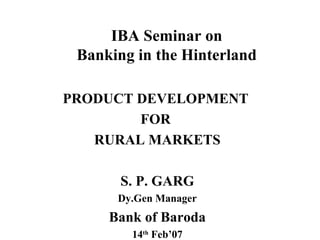echopal
- 1. IBA Seminar on Banking in the Hinterland PRODUCT DEVELOPMENT FOR RURAL MARKETS S. P. GARG Dy.Gen Manager Bank of Baroda 14 th Febâ07
- 2. RURAL CHALLENGES: India Growth Story & Eleventh Five Year Plan: Special Focus on Agriculture & Rural Segment To achieve 9 % growth projections, 4 % Farm growth is a must for self sufficiency, food security and for 2 nd Green Revolution â Deficit Areasâ for development of Rural Economy 1.   Investment and Credit Deficit 2.   Infrastructure Deficit 3.   Market Economy Deficit 4.  Knowledge Deficit With new emerging areas Rural Business : sustainable and profitable business proposition
- 3. RURAL MARKET SCENARIO APPROACHES TOWARDS RURAL MARKET Geographical Coverage Production and Potential Based Income Generation and Consumer spending Rural Markets ( 20,000 to 50,000 population) Tier2 and Tier3 cities contribute about 40-45% of FMCG and consumer durable items. Pyramid Approach for future Development (BOP-Model) Product Specific Target Segmentation
- 4. RURAL MARKET SEGMENTATION Rural Banking, Rural Credit, Rural Insurance Rural Marketing: Agri Inputs, FMCGProducts Rural Education, Extension, Research for Capacity & Capability Building &Employment Rural Investment & Infrastructure Development Rural Synergy with Corporates for value Chain based marketing, and Linkages. Rural to Global(Rural Exports) Rural NGOs, Rural BPOs and Other Segments
- 5. RURAL BRAND: AMBASSADORS & INSTITUTIONS Mahatma Gandhi: Sarvodaya & Antoydaya Dr. M.S. Swaminathan: Green Revolution V. Kurian: White Revolution Ela Bhatt: Women Empowerment NABARD: Farmers Club SBI: ADB Model BoB: GVK Model ITC: e-Chaupal ICICI: Business Facilitator/Correspondent IIMA & IRMA: Rural Management
- 6. RURAL BUSINESS MODEL RURAL R:Retail Business for Rural Community As (Consumer & Producer) U: Urban Facilities(PURA), Investment, Infrastucture R: Animal Hubandry & Allied Activities A: Agri-Production(Field Crops, Plantation ) L: Linkages & Synergy SEGMENT DIFFERENTIATION APPROACH R1: High Net Worth & High Investment R2: Mid Segment R3: Entry Level Segment & Cluster Based
- 7. New Avenues for Rural Business: Special Focus Horticulture, Plantation, Vegetable Growing, Floriculture,Aromatic and Medicinal Plants, Bio-Diesel Plants etc. for high Investment Opportunities Post Harvest and Food Processing & Logistics Services Seed Multiplication & Processing Diversified Activities: Animal Husbandry, Dairy Farming, Sericulture, Aqua-Culture & Others. Irrigation Projects & Wasteland Developments. Agro-Forestry Products Tie-Up Arrangements with Business Houses, Agri- Marketing Institutions, Industry Level Organizations with Supply Chain Management Module Rural Tourism & Other emerging areas.
- 8. CHALLENGES FOR PRODUCT DEVELOPMENT Need for aggressive strategies for Breakthrough Business (BB) instead of Business As Usual (BAU) approach . Change of Mindset & Commitment for Rural Business as profitable & sustainable Business Model Strong committed Organization Structure Focus on People, Products & Process Passion for Innovations & Initiatives Dynamic comprehensive Approach for Synergy and Partnership Models
- 9. CHALLENGES FOR PRODUCT DEVELOPMENT(Contd.) Product Differentiation with Great Values Regular review of Existing Products & Services Effective Implementation Strategy & Strong delivery Channels. Constant Clear cut communications with defined target groups (internal & external) IT-enabled strong MIS and CRM AND ULTIMATELY 360 0 Marketing Approach for Product Development & Successful Implementation .
- 10. To SUM UP DEVELOP âSMARTâ MODEL HAVE âARTâ TO BE IN âMARTâ & BECOME â SMARTâ THANK YOU









